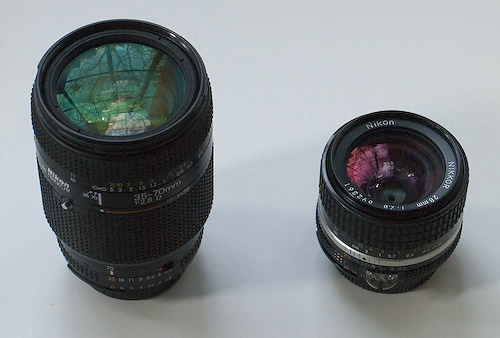Camera Lenses: a Crash Course
Page 4. Version 1.0, ©2008 by Dale Cotton, all rights reserved.
Zoom vs Prime

Fig 7. Two Nikon lenses: 35-70mm f/2.8 zoom and 28mm f/2.8 prime
A prime lens is one that offers only a single focal length, such as 35mm or 50mm or 500mm. Certain single focal lengths have become traditional for historical reasons from 35mm photography. Some of these are: 24mm, 28mm, 35mm, 50mm, 70mm, 75mm, 85mm, 90mm, 105mm, 135mm, 200mm, and 300mm. Until the second half of the 20th century, prime lenses were the only practical option, but once digital computers were enlisted in lens design it became possible for optical specialists to find acceptable solutions to the many issues involved in zoom lens design. Computer aided design especially helped by allowing designers to model the effects of using aspherical lens curvatures, opening up a new swath of solutions to these problems.
Nevertheless, zoom lenses still represent even more of a series of design compromises than primes, and especially so in the wide angle focal lengths for SLR cameras. Most lens manufacturers will offer a 28-200mm-e zoom due to consumer demand for an all-in-one solution, but no amount of computing power has ever solved all the problems inherent in such an extreme (7x) range of focal lengths, so these lenses invariably have optical problems. At the other extreme, I own a 35-70mm Nikon zoom (shown in Fig. 7) that has incredible sharpness and lack of distortions all across its range .. but then the range is only 2x and avoids the problematic wide angles beyond 35mm.

Fig. 8. Pancake prime lens – as small and light as one can get
In general a prime lens will provide the best optical performance possible at a given focal length. They also tend to be more compact and lighter than a typical zoom. The downside is obvious: being confined to a single focal length. This means:
- Carrying the added weight of multiple lenses if multiple focal lengths will be needed.
- Paying for multiple lenses if multiple focal lengths will be needed.
- Swapping from one lens to another (and back again) when taking pictures in many situations.
- Forgoing the exact focal length you require for a given composition, since that focal length may not even exist as a prime lens. Which in turn means shooting with the next wider focal length then cropping down the frame before printing, with a corresponding loss of resolution in the print.
Prime lens enthusiasts laugh when we make these complaints and tell us that these are the prices you pay for the ultimate in image quality. Maybe they have a point.